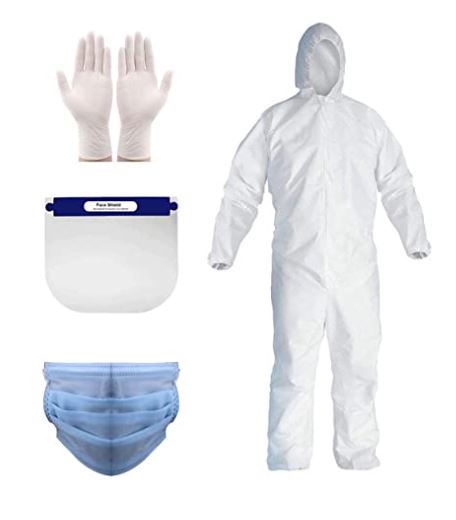Personal protective equipment (PPE) is a type of safety gear to protect the industry’s workers from injuries or infections at the workplace. Personal protective equipment can include 7 items such as gloves, masks, respirators, goggles, helmets, earbuds, and protective clothing. The type of Protectives they wear depends on the nature of work and hazardous conditions.

Wearing Protective Gear is important for the worker’s safety, as it can help to protect workers from injuries, illnesses, and other health risks. For example, workers in the healthcare department may use PPE such as gloves and masks to help prevent the spread of infections, while construction workers may use hard helmets and safety glasses to protect against falls and other accidents. For example, Worker in Pharmaceuticals wears helmets, while working in warehouse activities.
Training for PPE shall be provided to the workers at the workplace to teach them how to use these Protective equipment during working hours. As company is responsible for providing such equipment to the workers on duty, and for ensuring that the PPE is properly maintained and replaced when necessary.
PPE kits in Pharmaceuticals:
In pharmaceutical industries, a personal protective equipment (PPE) kit is used to protect workers from potential hazards that may be present in the environment. it also ensures product safety along with all these factors. These hazards may include chemical, biological, physical, or radiological agents. For example, workers handling chemicals or other hazardous materials may need to wear gloves to protect their hands from contact with these substances. Similarly, workers in a laboratory may need to wear masks or respirators to protect their mouths and nose from inhaling hazardous particles. Persons involved in the manufacturing process must wear proper gowning/PPE kit to protect against chemicals like; IPA.
Donning and Doffing of PPE:
Donning and doffing refers to the process of putting on and taking off personal protective equipment (PPE). Proper donning and doffing of PPE are important to know that they are used correctly to prevent contamination or cross-contamination.
Here are some general guidelines for donning and doffing PPE wear order:
- Wear Shoes followed by a Shoe cover
- Wear Gloves without touching your fingers to the outer layer areas of the gloves
- Use IPA to sanitize gloves
- Wear hairnet
- Put mask preferred N95
- Put googles
- Use again IPA to sanitize gloves
- Put on Primary Gown
- Cross over bench
- Enter into a secondary area
- Change factory provided shoes
- Again sanitize your hand’s gloves
- Wear secondary gowning
- Inter into areas
Referring Article: Gowning Procedure
Types of PPE kit:
- Gloves: To protect the hands from contact with hazardous materials along with preventing product contamination
- Masks: To protect the mouth and nose from inhaling hazardous particles
- Goggles: To protect the eyes from splashes and contact with hazardous materials
- Lab coats: To protect the body from splashes and spills of hazardous chemicals
- Aprons: To protect the body from splashes and spills of hazardous materials
- Face shields: To protect the face from splashes and spills of hazardous chemicals
- Earplugs: To protect ears from noisy areas.
So, In Pharmaceutical industries, It becomes important to provide training to the employees on how to use PPE as per the company SOP. This includes; properly fitting masks and respirators, properly donning and doffing gloves, and disposing of PPE correctly to prevent contamination. For example, workers handling manufacturing, coating, or interacting with hazardous chemicals may need to wear masks or gloves to help prevent the transmission of diseases.
Related: Fire Safety Practices in Pharmaceutical Industries
Guidelines/ Procedure to use PPE kit:
Companies have their own guidelines or SOPs in place, to ensure the proper usage of PPE kits. But, Here are some general guidelines for using PPE:
- It is important to select the right type of PPE for the specific work being performed. Companies provide different types of PPE to workers according to their work.
- PPE should be used according to the given procedure (SOP). This includes, how to wear, where to wear, and how to dispose of theme.
- PPE should be inspected well before its use to ensure that it is in good condition and functioning properly. If any defects or damage are noticed, the PPE should be replaced.
- PPE should be worn and used properly in order to provide the necessary protection. This includes following proper donning and doffing procedures and wearing the PPE in the correct way. replace with a new one whenever needed.
- PPE should be disposed of properly to prevent contamination and cross-contamination. This may include following special disposal procedures, such as placing used PPE in the designated place in the area.
Workers must be well-trained in how to use PPE and follow the instructions that follow to ensure their own safety and the efficacy of the products.
PPE MOC
Personal protective equipment (PPE) can be made of a variety of materials. Some common materials used in the manufacture of PPE include:
Fabric: Some of the PPE, such as aprons, lab coats, and gowns, are made of fabric. Fabric materials may include cotton, polyester, or a blend of these and other fibers.
Rubber or synthetic rubber: Gloves, slippers, and other types of PPE that are designed to provide a barrier against liquids or chemicals are often made of rubber or synthetic rubber materials. These materials are resistant to water and chemicals and can provide a good grip.
Plastic: Goggles, face shields, and other types of PPE that are designed to protect the face and eyes are often made of plastic materials. Plastic materials may include polycarbonate, which is resistant to impact and scratches.
Metal: Hard helmets and other types of protective headwear may be made of metal materials, such as aluminum or steel, to provide protection against impacts.
Foam: Earplugs and other types of PPE that are designed to protect the ears may be made of foam materials.
Frequently Asked Questions:
Ans: Yes, training is generally needed to use personal protective equipment (PPE) correctly and effectively. Training for PPE shall be provided to the workers at the workplace to teach them how to use these Protective equipment during working hours.
Ans: Personal protective equipment (PPE) should be stored in a clean, dry, and easily accessible location. The specific storage requirements for PPE will depend on the type of PPE and the hazards present in the workplace. PPE should be stored in a way that prevents it from becoming contaminated by dust, dirt, or other contaminants
Ans: 7 items such as gloves, masks, respirators, goggles, helmets, earbuds, and protective clothing
Ans: PPE stands for Personal protective equipment

Naresh Bhakar is the Founder and Author at Pharmaguddu.com, bringing his extensive expertise in the field of pharmaceuticals to readers worldwide. He has experience in Pharma manufacturing and has worked with top Pharmaceuticals. He has rich knowledge and provides valuable insights and data through his articles and content on Pharmaguddu.com. For further inquiries or collaborations, please don’t hesitate to reach out via email at [email protected].
